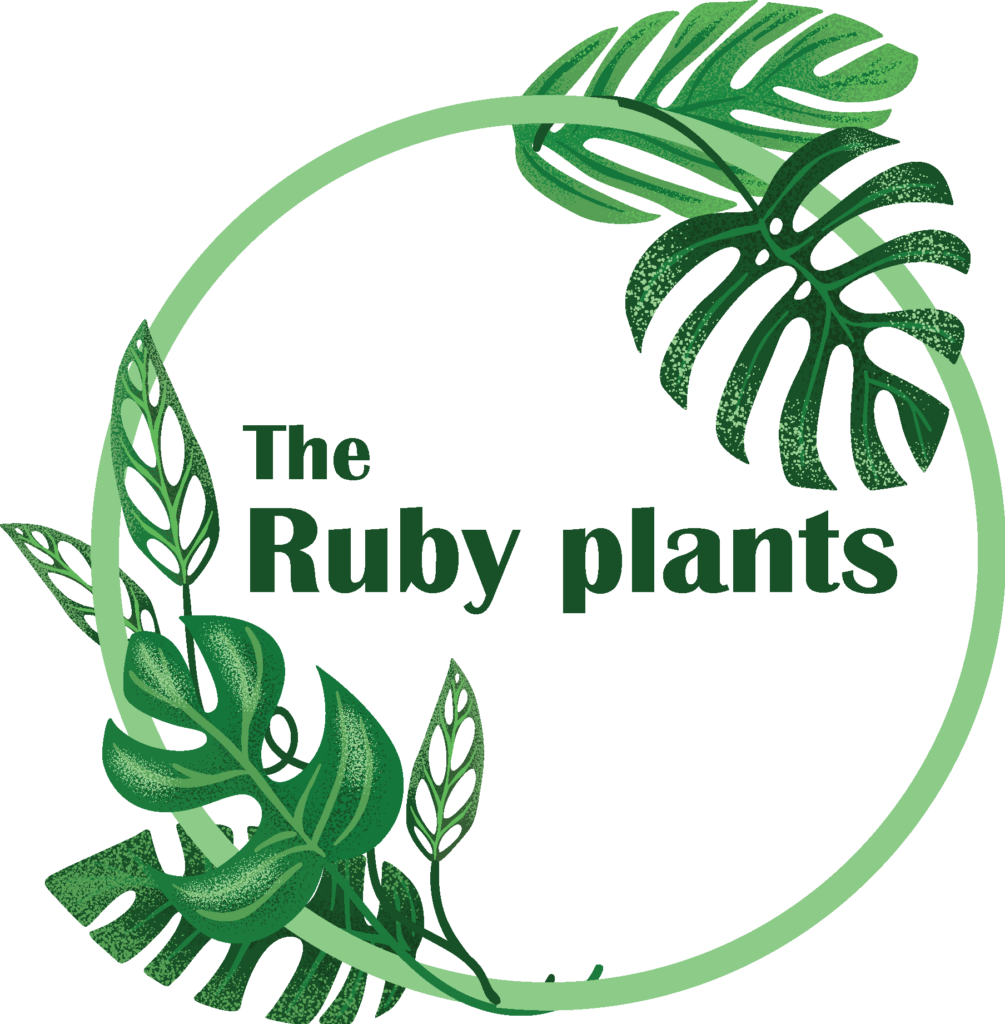Quality Healthy Indoor & Outdoor Plants
We Guarantee Excellent Service with Great Advice
Wide Range Of Plant Selections
Friendly & Knowledgeable Team
Affordable Prices
Flexible Delivery Times
Personalised Advice To Suit Your Plants’ Needs
Request A Free Quote
The Ruby Plants – Best Place For Indoor & Outdoor Plants in Brisbane
Jade and Simon from The Ruby Plants.
Coming from a city where concrete dominated the landscape, we found ourselves needing a breath of fresh air. The scorching sun beat down on us relentlessly, leaving us longing for the shade of trees and the beauty of plants.
Our lives took a beautiful turn when we had the opportunity to visit Australia where we were amazed by green landscapes and the cool breeze which made us realize and value the beauty of nature.
We fell in love with the green way of life in Australia. We saw how plants could transform spaces, both indoors and outdoors, into places of peace and natural beauty.
Sharing this feeling with their fellow Australians became our mission.
Driven by passion, we opened The Ruby Plants. Our vision was to provide healthy and stunning foliage indoor plants and outdoor plants and trees for transforming indoor spaces, landscaping and gardening projects. We wanted to create a corner where plant enthusiasts, gardeners, business owners, and garden contractors across Australia could find inspiration and the tools to create their own green space.
At The Ruby Plants, we handpicked every plant, ensuring they were healthy, vibrant, and ready to bring life to any space. We believe everyone should have access to various plants with affordable prices and awesome service by sharing our knowledge and passion with each customer.
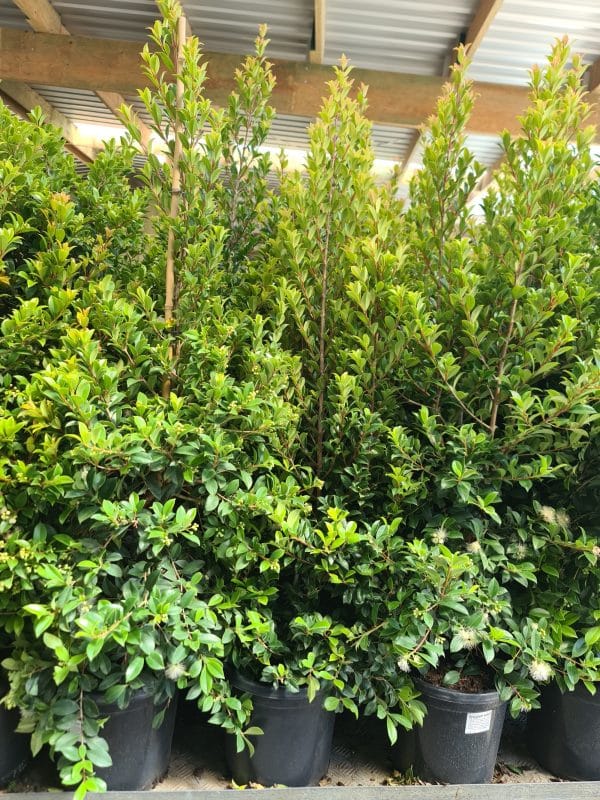
Why Choose Us?
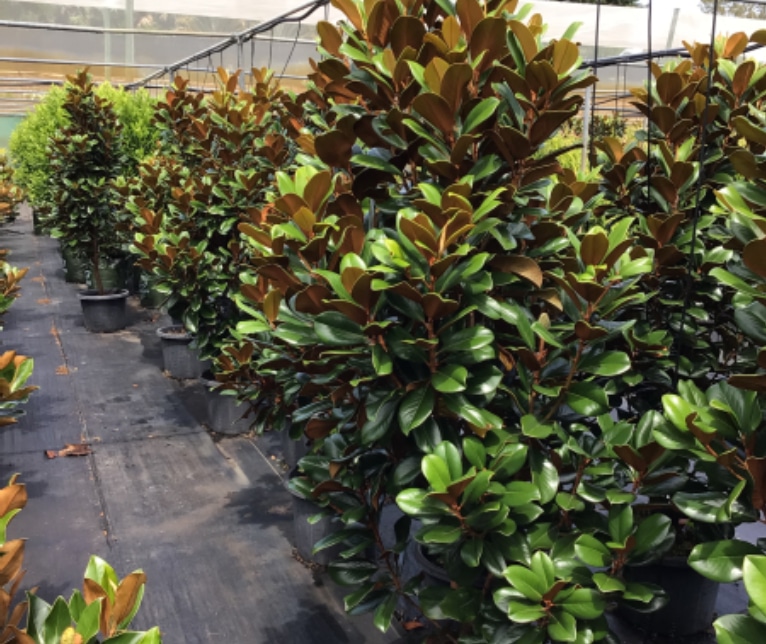
Wide Range of Plant Selections

Personalised Advice
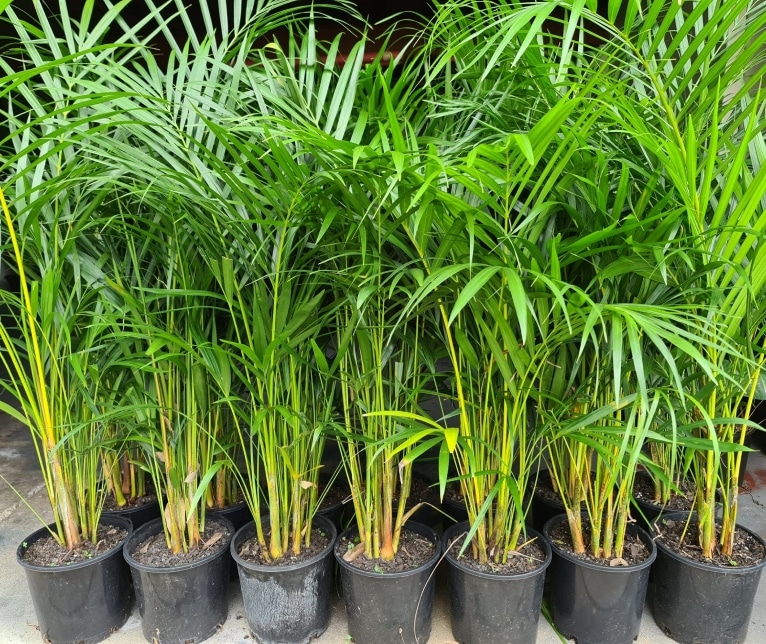
Customer Satisfaction Guaranteed
Plants Available at Our Nursery
INDOOR
- Aglaonema
- Angel Wings
- Anthurium
- Bird of Paradise
- Calathea
- Chili
- Ctenanthe
- Dragon Tail
- Elephant Ear
- Ficus/Figs
- Golden Heart
- Golden Mosaic
- Happy Plant
- Licuala
- Monstera
- Orchids
- Peace Lily
- Peperomia
- Philodendron
- Snake Plant
- Spider Plant
- Staghorn Fern
- Stromanthe
- Umbrella Tree
- Zanzibar
HANGING/VINES
- Devil’s Ivy
- English Ivy
- German Ivy
- Lipstick Plant
- Manjula
- Marble Queen Pothos
- Silver Pothos
- Sedum
- Syngonium
INDOOR PALM
- Alexandra
- Bamboo
- Cascade
- Kentia
- Rhapis Lady
OUTDOOR
- Bird of Paradise
- Casuarina
- Dracaena
- Frangipani
- Heliconia
- Lemon
- Magnolia
- Olive
- Red Back Ginger
- Shell Ginger
- Silver Lady Fern
- Star Jasmine
- Xanadu
HEDGING
- Lilly Pilly
- Murraya
- Red Robin
- Snow Maiden
OUTDOOR PALM
- Bangalow
- Foxtail
- Golden Cane
Plant Care Tips

Monstera Deliciosa
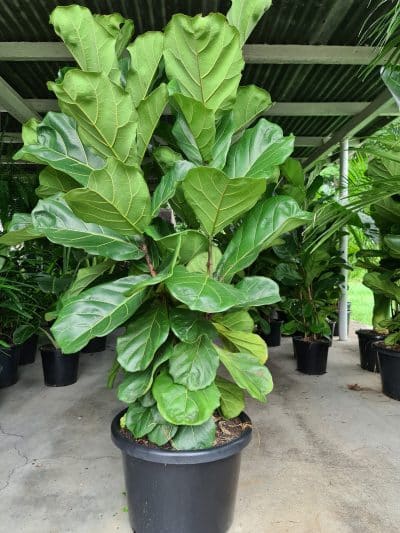
Fiddle Leaf Fig
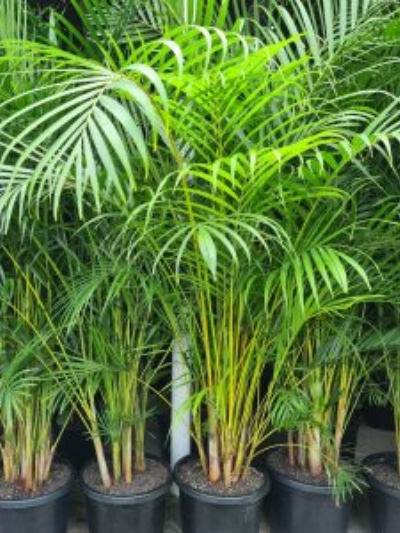
Golden Cane Palms
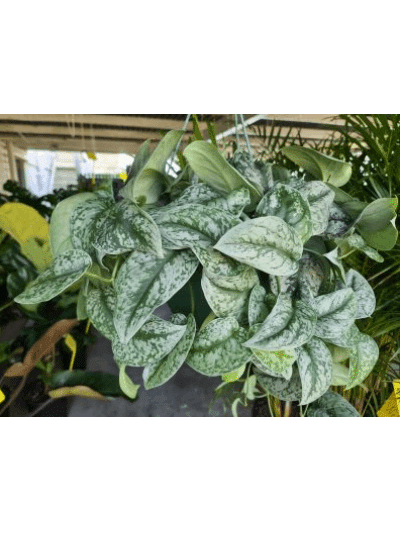
Satin Pothos/Silver Pothos

Peace Lily
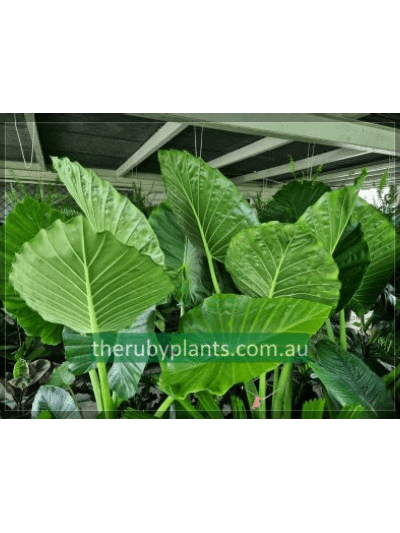
Elephant Ear
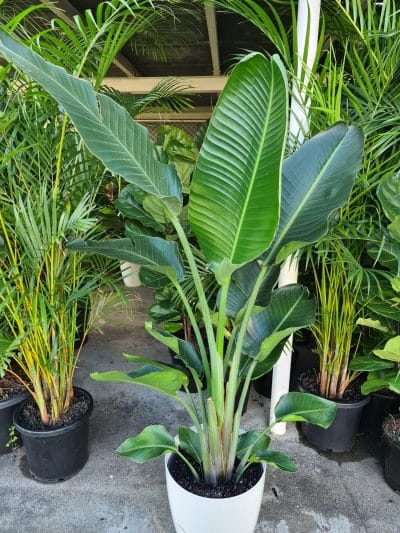
Bird of Paradise
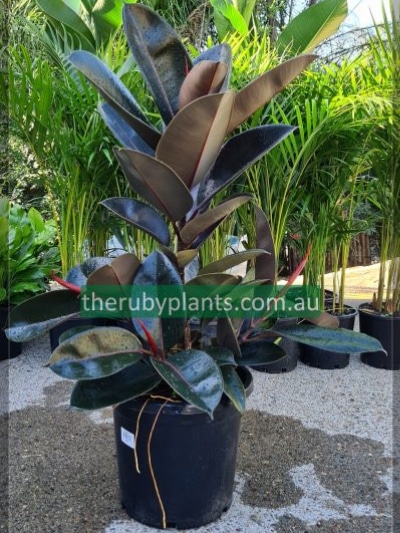
Ficus Elastica
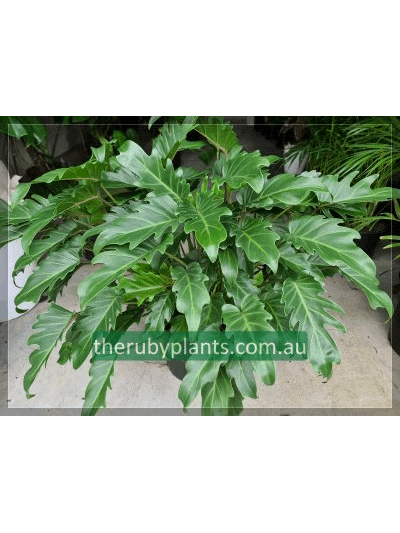
Philodendron Xanadu
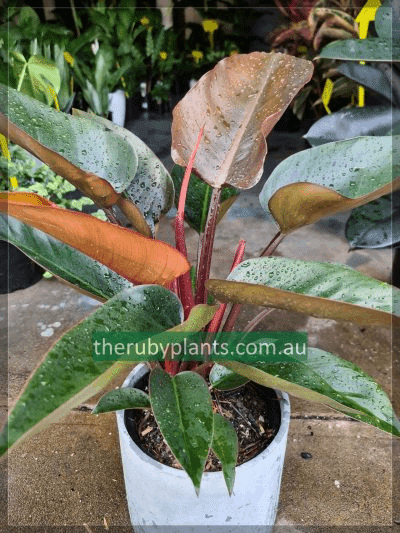
Philodendron Rojo Congo
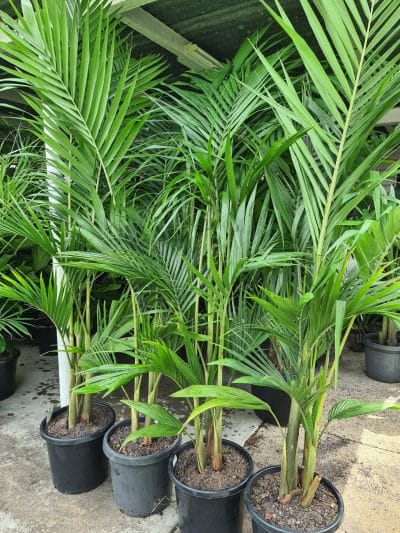
Bangalow Palm
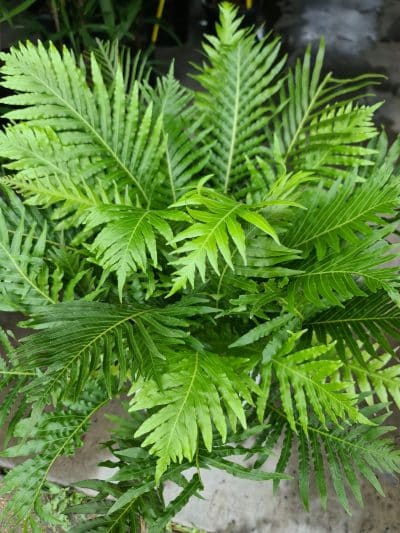
Silver Lady Fern
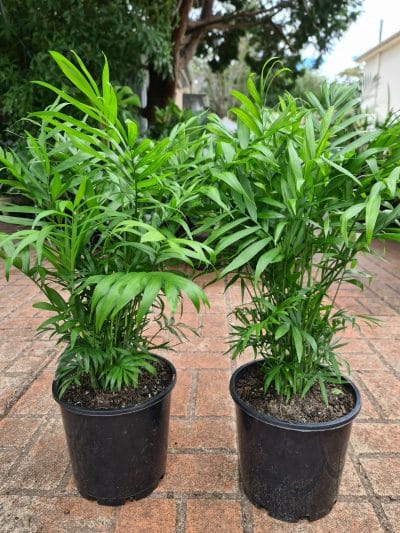
Parlor Palm
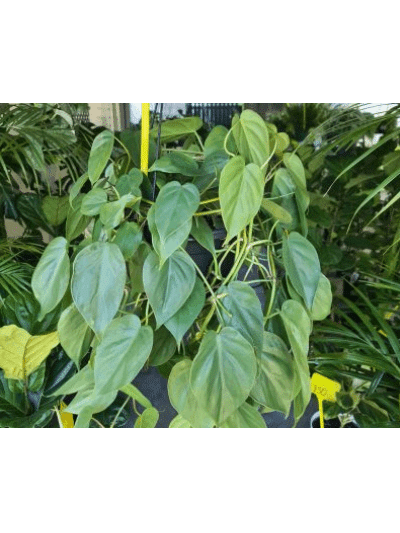
Philodendron Heartleaf

Sansevieria Moonshine
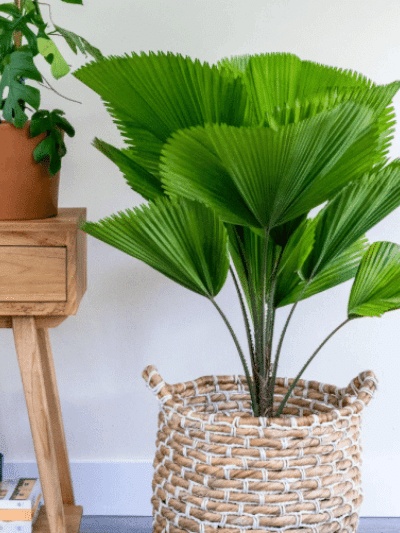
Licuala Grandis
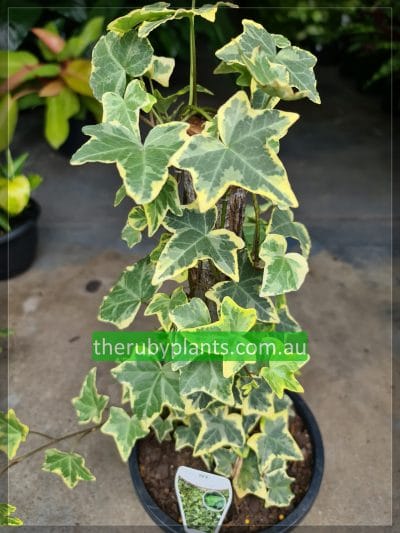
English Ivy
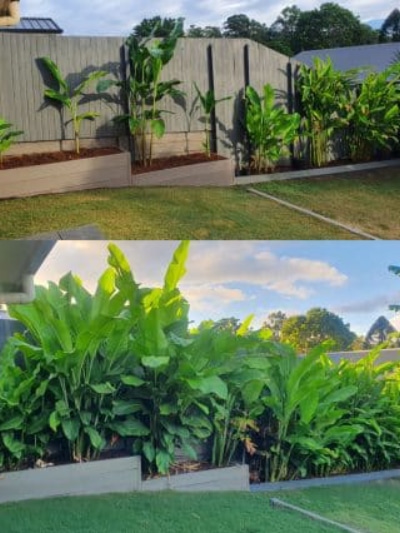
Heliconia
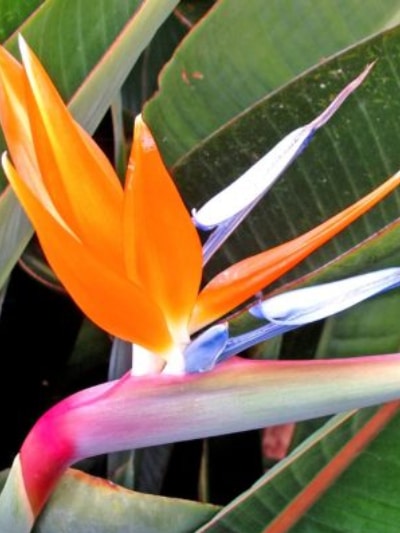
Bird of paradise strelitzia reginae
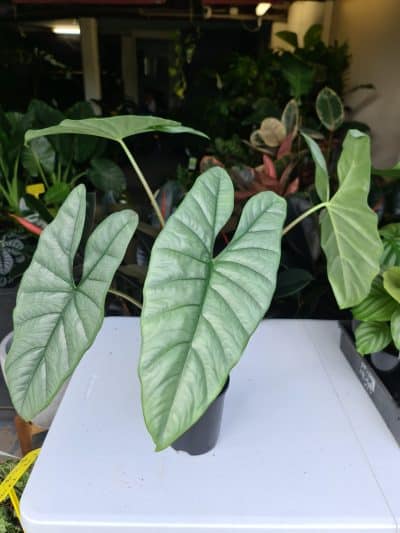
Alocasia Corazon
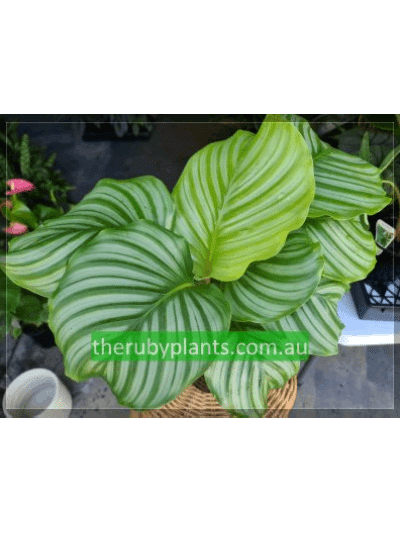
Calathea Orbifolia
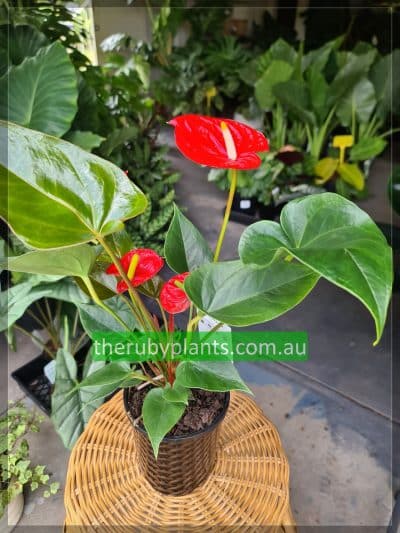
Anthurium Andreanum
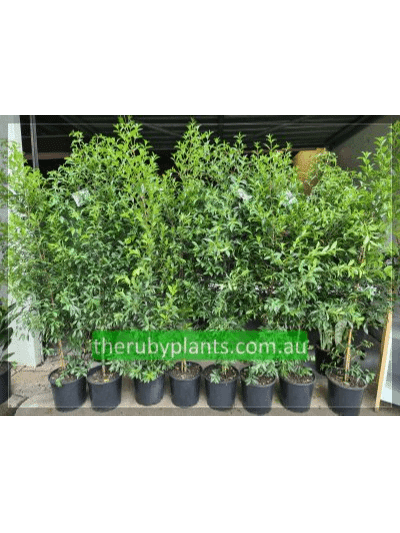
Syzygium australe
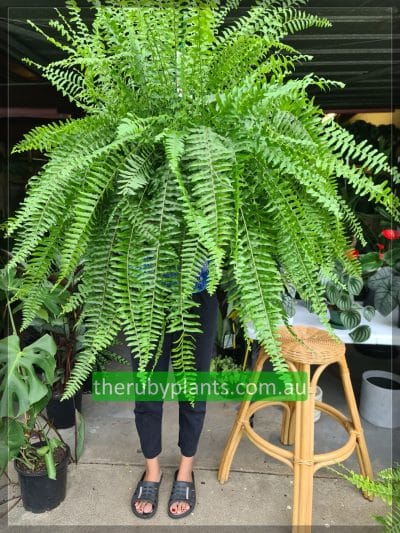
Boston fern
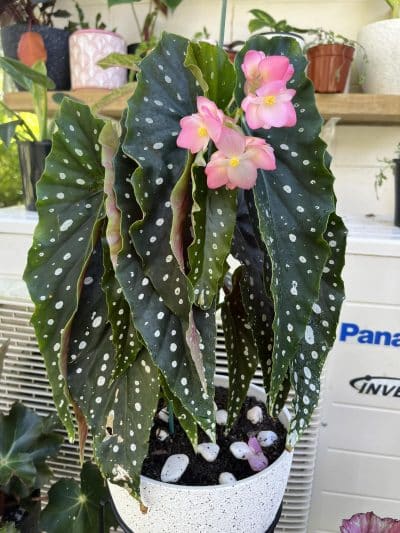
Begonias
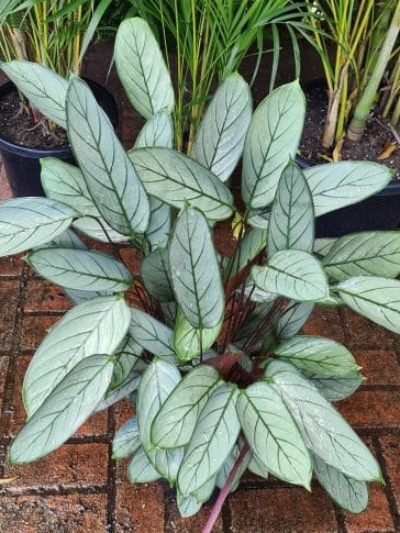
Ctenanthe Grey Star
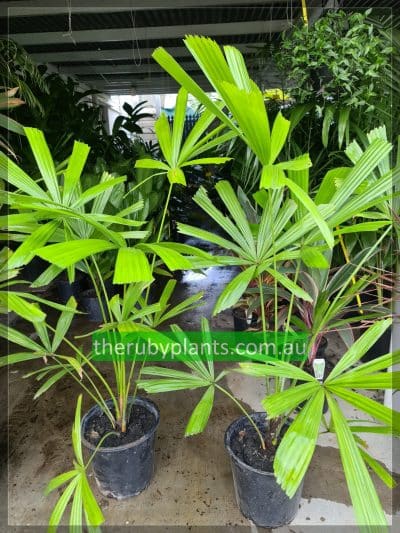
Australian Fan Palm
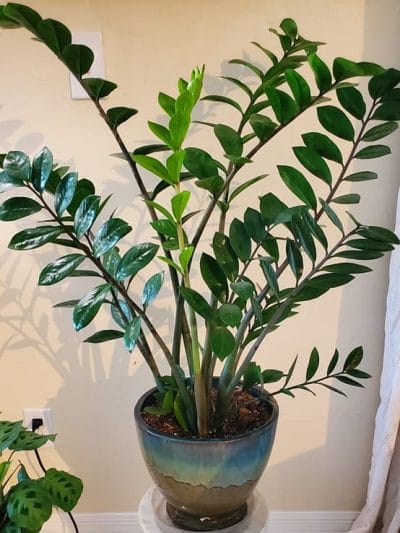
Zamioculcas Zamiifolia
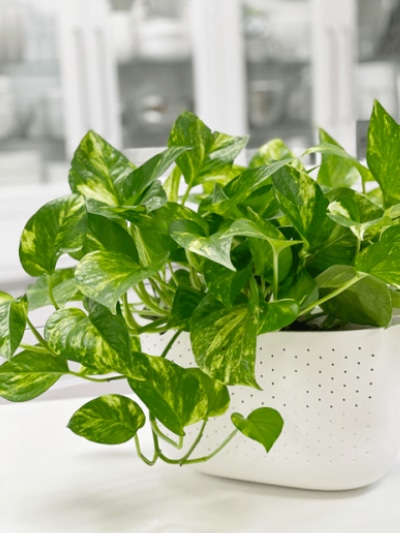
Devil’s Ivy

Monstera Deliciosa
They can grow indoor in medium/bright areas or outdoor in SHADE or PARTIAL SHADE
Light: indirect sunlight or filtered sunlight, morning sun before 10AM; Set indoor plants outside at least once a year in direct sunlight to encourage lush growth.
Water: The soil will need to dry out slightly in between.
- Indoor – water once a week or every 10 days
- Outdoor – water once a week
- Water only occasionally in fall and winter.
- Water until water comes out of the pot. Do not let the plant sit in water.
Temperature and Humidity: best in between 18 to 25 degrees Celsius
Fertilizer: three or four times a year. Do not feed during the winter.
Repotting: every two years or so
Soil: Well-drained soil, moderately moist soil.
Native Area: Central America
Toxicity: Toxic to pets

Fiddle Leaf Fig
They can grow indoor in medium/bright areas or outdoor in SHADE or PART SHADE indirect light.
Light: Indirect sunlight or filtered sunlight, Medium/Bright indirect light is best, morning sun before 10AM; rotate your fiddle-leaf fig every few days so a different part faces the source of sunlight.
Water: The soil will need to dry out slightly in between.
- Indoor – water once a week or every 10 days
- Outdoor – water once a week
- Water only occasionally in fall and winter.
- Water until water comes out of the pot. Do not let the plant sit in water.
- Clean the leaves with a damp cloth every week or fortnightly
Temperature and Humidity: Keep them away from drafty areas, as well as air-conditioning and heating vents.
Fertilizer: three or four times a year. Do not feed during the winter.
Repotting: every two years or so
Soil: It thrives most in well-draining soil, medium moisture
Native Area: Tropical western Africa
Toxicity: Toxic to pets

Golden Cane Palms
They can grow indoor in bright areas or outdoor in SHADE to partial sun; They can grow in FULL SUN when they are mature in the ground.
Light: Bright areas. To keep indoor palms healthy, it can benefit your palm to bring it outdoors in warm weather to be exposed to diffused sunlight
Water: They like moist soil but the soil will need to dry out slightly in between.
- Indoor – water every 5 days
- Outdoor – water every 2 or 3 days on sunny days and twice a week in winter
- Water until water comes out of the pot. Do not let the plant sit in water
Temperature and Humidity: Make sure to bring potted planta back indoors before the temperature drops below 10 degrees Celsius; keep the plant away from cold windows, air conditioners, and heat sources; they love high humidity
Fertilizer: fertilizing from spring to early fall with a liquid fertilizer. Do not feed it during the late fall and winter.
Repotting: repot it every other year or so; Select a sturdy container that is roughly 2 inches larger in diameter than the existing one; Replant the palm at the same depth as it was previously planted.
Soil: Moist, well-drained
Native Area: Madagascar
Toxicity: Non-toxic
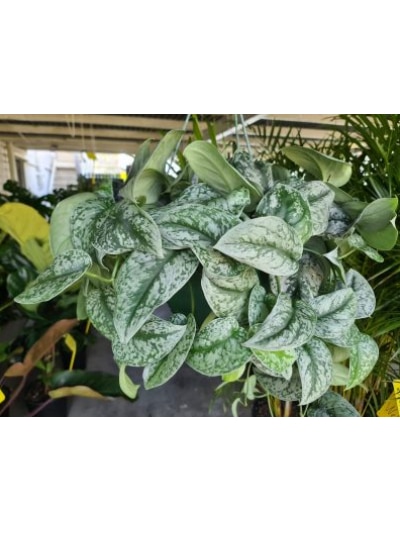
Satin Pothos/Silver Pothos
They can grow indoor in medium/bright indirect light areas or outdoor in SHADE or PARTIAL SHADE but can tolerate low indirect light.
Light: They can grow indoor in medium/bright indirect light areas or outdoor in SHADE or PARTIAL SHADE but can tolerate low indirect light.
Water: Water every 1-2 weeks when the top 2 inches of soil is dry, NEVER allow the plant to dry out completely.
- In Summer: can water every week
- In Winter: you can cut back on watering significantly – every 10 days or fortnightly
- Water until water comes out of the pot. Do not let the plant sit in water
Temperature and Humidity: Make sure to bring it back indoors before the temperature drops below 16 degrees Celsius; Keep them away from drafty windows or air vents
Fertilizer: Regular fertilizing during the spring and summer months; Use a balanced liquid fertilizer once a month during watering; Do not feed during the fall and winter.
Repotting: Requires repotting only every two or three years
Soil: Airy, fertile, and moist but well-draining
Southeast Asia: Madagascar
Toxicity: Toxic to pets
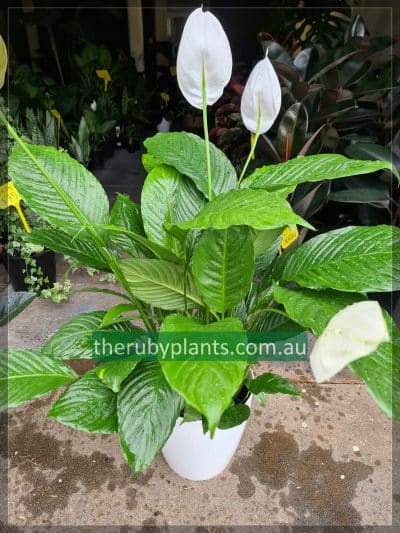
Peace Lily
Indoor plant – it doesn’t like the hot weather – put far away window.
Light: Medium light, indirect sunlight
Water: Water when the top inch of soil is dry, NEVER allow the plant to dry out completely
- In summer water twive a week or every 5 days
- In winter once a week
- Water until water comes out of the pot. Do not let the plant sit in water. Do not let the plant sit in water.
Temperature and Humidity: They prefer moist warmth. The best temperature range for the peace lily is 18 to 27 degrees Celsius; HAVE TO bring it back indoors in winter
Fertilizer: weekly in the summer or use slow-release fertilizer at the beginning of the season. Do not feed during the winter
Repotting: Requires repotting only every two or three years
Soil: Like a rich, loose potting soil containing plenty of organic material; Moist but well-drained – they are also very sensitive to too-damp soil conditions.
Central America, Asia: Madagascar
Toxicity: Toxic to humans and pets

Elephant Ear
They can grow indoor in bright areas or outdoor in SHADE or PARTIAL SHADE
Light: indirect sunlight or filtered sunlight, morning sun before 10AM
Water: Keep elephant ear plants consistently moist.
- Indoor – water every 5 days
- Indoor – water every 5 days
- Do not let the plant sit in water.
Temperature and Humidity: They prefer moist warmth. The best temperature range for the peace lily is 18 to 27 degrees Celsius; HAVE TO bring it back indoors in winter
Fertilizer: Do not let the plant sit in water.
Repotting: Requires repotting only every two or three years
Soil: indirect sunlight or filtered sunlight, morning sun before 10AM
Central America, Asia: Madagascar
Toxicity: Toxic to humans and pets

Bird of Paradise
They can grow indoor in bright areas or outdoor in PARTIAL SHADE. They can grow in FULL SUN when they are mature in the ground.
Light: bright areas
Water: Keep the soil continually moist throughout the year. While it should not be waterlogged, expect to water it every 3 days in the spring and summer as it loses moisture through its big leaves. If overwatered, the plant will develop crunchy brown leaves. If underwatered, the leaves farthest from the center will turn yellow.
- Indoor – water once a week
- Outdoor – water every 3 days.
- Do not let the plant sit in water.
Fertilizer: Feed it in the springtime with slow-release pellets or weekly during the growing season with liquid fertilizer. Do not feed during the winter.

Ficus Elastica
They can grow indoor in bright areas or outdoor in SHADE to PARTIAL SHADE; They can grow in FULL SUN when they are mature in the ground;
Light: Bright areas, indirect sunlight or filtered sunlight
Water: They like to be kept steadily moist but not soaked. They like moist soil but the soil will need to dry out slightly in between. Water when the top inch of soil is dry.
- Indoor: Burgundy – once a week; Ruby and Tineke: every 5 days
- Outdoor – water every 2 or 3 days on sunny days and every 5 days in winter
- Water until water comes out of the pot. Do not let the plant sit in water
Temperature and Humidity: best kept in moderate to warm temperatures between 15 to 25 degrees Celsius, with moderate humidity as well
Fertilizer: Feed the plant a weak liquid fertilizer throughout the growing season Spring to early Fall. Do not feed it during the late fall and winter. Some experts recommend only lightly fertilizing indoor plants to prevent stretching and plants becoming root-bound because they grow too fast.”>Repotting: They grow fairly quickly under the right conditions and will need to be repotted every year until the plant reaches the height you want. Larger plants can be difficult to repot, so if you can’t move the container, scrape off a few inches of potting media and replace it with new potting soil.
Soil: Moist, well-drained
Asia: Madagascar
Toxicity: Toxic to pets

Philodendron Xanadu
They can grow indoor in bright areas or outdoor in SHADE or PARTIAL SHADE.
They can grow in FULL SUN when they are mature in the ground.
Light: Bright areas
Water:
- Indoor – water every 5 days
- Outdoor – water twice a week, for Xanadu – once a week. In summer, water every 2 or 3 days
- Water only occasionally in fall and winter.
- Do not let the plant sit in water.
Temperature and Humidity: best kept in moderate to warm temperatures between 15 to 25 degrees Celsius, with moderate humidity as well
Fertilizer: Do not feed during the winter.

Philodendron Rojo Congo
They can grow indoor in bright areas or outdoor in SHADE or PARTIAL SHADE
Light: bright area, indirect sunlight or filtered sunlight or morning sun before 10AM, afternoon sun 3PM-5PM
Water: It prefers consistently moist soil. Water when the top 2″ of soil is dry.
- Indoor – water once a week or every 10 days
- Outdoor – water every 5 days
- Water only occasionally in fall and winter.
- Water only occasionally in fall and winter.
Temperature and Humidity: Keep them away from drafty areas, as well as air-conditioning and heating vents. They don’t like cold drafts and sudden temperature fluctuations. They like moderate humidity. Occasionally, you can mist and then gently wipe leaves with a cloth to clear away dust from the leaf surface fortnightly or once a month.
Fertilizer: once a month in Spring and Summer and every 6 weeks in Fall. Do not feed during the winter.
Repotting: when some roots were appearing out of the drain holes, and it was heavier with foliage on one side which made it unable to stand up on its own. Normally, repot once every two to three years to give the plant fresh nutrients
Soil: it thrives most in well-drained soil, moderately moist soil.
Native Area: the humid forests of South America
Toxicity: Toxic to humans and pets

Bangalow Palm
They can grow indoor in bright areas or outdoor in SHADE to PARTIAL SUN; They can grow in FULL SUN when they are mature in the ground;
Light: They prefer bright areas indoor or outdoor partial shade to partial sun. To keep indoor palms healthy, it can benefit your palm to bring it outdoors in warm weather to be exposed to diffused sunlight
Water: The Bangalow palm likes to be kept moist, especially while it’s getting established. But once established, keep it dry in winter and moist in summer. The soil will need to dry out slightly in between. When grown indoors, palm trees need consistently moist soil that doesn’t become waterlogged (so a pot with good drainage is essential).
- Indoor – water every 5 days
- Outdoor – every 5 day or twice a week on sunny days
- Water until water comes out of the pot. Do not let the plant sit in water
Temperature and Humidity: It tolerates cold temperatures better than some palms making it cold-hardy.
Fertilizer: Fertilise fortnightly from Spring to Fall with liquid fertilizer. When the palms get bigger, give them slow-release fertilizer.
Repotting: Shallow roots make the Bangalow palm safe to plant near pools and structures. They also make a good container plant when young. Repot every 2 years
Soil: Moist, well-drained
Native Area: Australian rainforest
Toxicity: Non-toxic

Silver Lady Fern
They can grow indoor in bright light with high humidity area but do best outdoor in SHADE or PARTIAL SHADE
Light: They prefer partial shade or dappled sunlight at the very moist, indirect sunlight or filtered sunlight
Water: Water them frequently during the warmer months to keep the potting mixture moist, which will ensure proper growth. Slightly reduce watering when the temperature falls below 12° degrees Celsius and let the topmost layer of potting soil dry out between waterings. Avoid watering from overhead as the foliage can get damaged if it stays wet for an extended time.
Temperature and Humidity: They prefer a slightly warmer temperature; Keep them away from cold drafts. If they begin to look brown along the leaf margins, they are likely suffering from lacking humidity. Try to increase the humidity. To maintain the humidity level, place the pot over a tray filled with moist pebbles throughout the warm season.
Fertilizer: Feed the plant a slow release fertilizer once at the beginning of the growing season Sring and Summer.
Repotting: repot when the roots come out on the surface of the pot; about once every two years.
Soil: They prefer a rich, humus potting mix. Mulch the surface of the soil to keep the roots moist and cool. They do not like mucky conditions
Native Area: Fiji, New Caledonia and the Pacific Islands
Toxicity: Toxic to pets

Parlor Palm
They can grow indoor from low to bright light but do best in medium to bright light or outdoor in SHADE
Light: Low to bright light, indirect sunlight or filtered sunlight
Water: Water when the top inch of soil is dry. They are sensitive to overwatering.
Temperature and Humidity: best kept between 18 to 28 degrees Celsius, with moderate humidity as well. They can tolerate a low of 10 degrees Celsius. Keep them away from cold drafts near windows, vents, and outside doors.
Fertilizer: Feed the plant a weak liquid fertilizer once or twice throughout the growing season Spring to early Fall. Do not feed it during the late fall and winter.
Repotting: They grow relatively slowly so you shouldn’t have to repot it more than every 2 years.
Soil: Outdoors, any well-drained soil; indoors, use a peaty soil-based potting mix
Native Area: Rainforests of southern Mexico and Guatemala
Toxicity: Non-toxic

Philodendron Heartleaf (Sweetheart)
They can grow indoor in medium/bright indirect light areas or outdoor in SHADE or PARTIAL SHADE but can tolerate low indirect light;
Light: Medium or bright indirect light
Water: Water every 1-2 weeks when top 2 inches of soil is dry, NEVER allow the plant to dry out completely
Temperature and Humidity: Make sure to bring it back indoors before temperature drops below 16 degrees Celsius; Keep it away from drafty windows or air vents
Fertilizer: Can apply a diluted fertilizer solution once or twice during spring and summer. Do not feed during the winter
Repotting: Requires repotting only every two or three years.
Soil: Well-drained
Native Area: Tropical Central and South America
Toxicity: Toxic to humans and pets

Sansevieria Moonshine (Snake Plant)
Sansevieria Moonshine plants are pretty low-maintenance.
Light: Bright indirect light / morning sun.
Water: Moonshine is drought-tolerant. Let the soil dry out between watering.
Temperature and Humidity: Make sure to bring it back indoors before temperature drops below 13 degrees Celsius.
Fertilizer: Apply a diluted fertilizer solution once or twice a year during spring and summer. Do not feed during the winter
Repotting: Requires repotting only every 2 to 5 years.
Soil: The standard potting mix used for succulents and cacti is suitable
Native Area: West Africa
Toxicity: Toxic to humans and petsSansevieria species contains compounds known as saponins. These may be mildly toxic to humans and pets. Upon ingestion, they may cause irritation in the stomach or in the mouth.
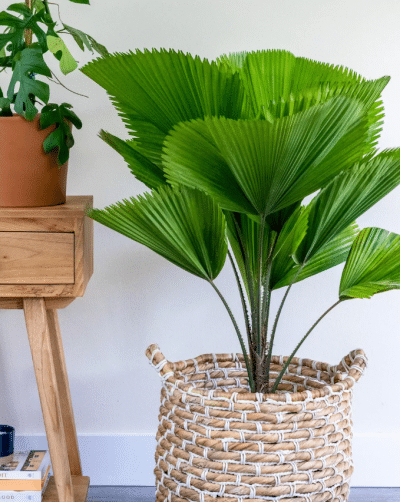
Licuala grandis (Ruffled Fan Palm)
They can grow in partial shade or dappled sun when small and young, and when mature is comfortable in full sun as long as the humidity is high.
For dramatic landscape effect, cluster ruffled fan palm beneath a tall shade tree or shaded building foundation. Indoors it will become a nice container specimen as long as it receives very bright light, warmth and its soil never becomes dry.
They are ideal for pots, for inside and veranda with early morning sun. These plants have been in 50% shade cloth. Slow growing to a height of 3 metres.
Light: Bright indirect light
Water: Water every 1-2 weeks when top 2 inches of soil is dry; every 5 days indoors / twice a week outdoors. Water until water comes out of the pot. Do not let the plant sit in water.
Temperature and Humidity: It is advisable to plant this palm in regions only where temperatures do not fall below 3 degrees C.
Fertilizer: This palm responds favorably to frequent, light fertilization. Fertilise with Dynamic Lifter or slow release osmocote.
Repotting: Requires repotting only every two or three years.
Soil: Well-drained soil.
Native Area: The plant is native to the Vanuata islands off the coast of Australia.
Toxicity: Toxic if ingested.
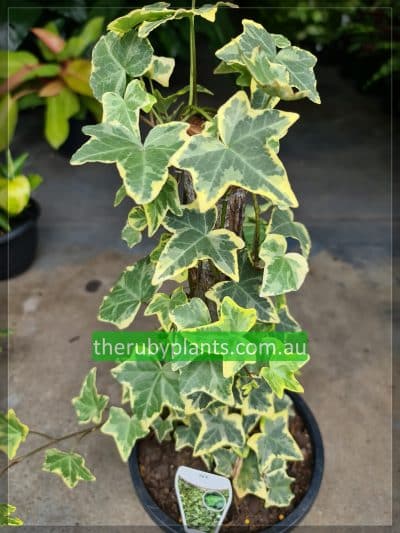
English ivy (Hedera helix)
English ivy is relatively easy to care for and looks great, either hanging or dangling its vines from a shelf.
Light: Part shade to full shade. Ivy grown indoors needs lots of bright, indirect light in summer but can benefit from some direct light in winter.
Ivy needs protection from winter winds as well as the hot summer sun
Water: Let the top of the soil dry to the touch between waterings. Especially in dry, winter air, it will benefit from regular misting of the foliage.
Ivy should not be kept in standing water or overly wet soil.
Temperature and Humidity: Best between 70 and 90 degrees Fahrenheit. It does not like cold winter wind or high summer heat.
Fertilizer:Feed English ivy every two weeks during the spring and summer season, using a 20-20-20 fertilize.
Repotting: ivy plants can be repotted once a year. Always repot with new potting soil to ensure adequate nutrition.
Soil: If indoors, ivy does best in potting mix that is loose and well-drained.
Native Area: Europe and Western Asia.
Toxicity: Toxic to humans and animals if ingested.
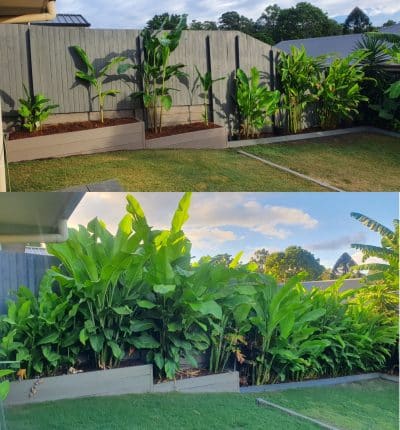
Heliconia
Heliconia is a beautiful tropical plant that is prized for its vibrant and exotic flowers. If you’re lucky enough to have one of these plants, here are some tips for caring for it:
Light: Heliconia thrives in a spot with semi-shade or a south facing garden but protection from harsh afternoon sun is required.
Water: Keep the soil moist, but not waterlogged. Water your plant regularly, allowing the top inch of soil to dry out slightly between waterings.
Humidity: Heliconia loves humidity. If your home is dry, you can use a humidifier or place a tray of water near the plant to increase the humidity.
Fertilizer: Feed your Heliconia with a balanced fertilizer every 2-3 weeks during the growing season (spring and summer). Be sure to follow the instructions on the fertilizer package.
Pruning: Remove any dead or damaged leaves as they appear. You can also prune your plant to control its size and shape.
Repotting: Heliconia prefers to be slightly root-bound, so only repot it when necessary. When you do repot, use a well-draining potting mix.
By following these care tips, you can help your Heliconia thrive and enjoy its beautiful flowers for years to come.
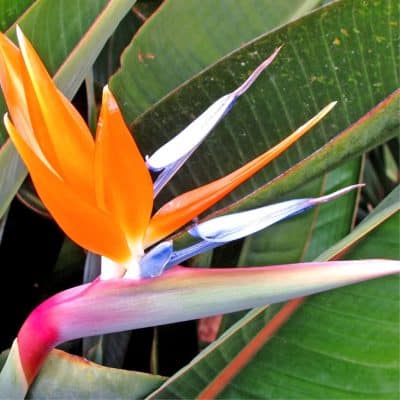
Bird of paradise strelitzia reginae
Light: They can grow in full to partial sun. This plant needs bright light, including some direct sunlight to thrive.
When grown indoors, a good position is in a room with east or west facing window.
Water: Keep the soil continually moist throughout the year. Water it until you see the water draining from its drainage holes, but make sure it does not sit in a pool of water. If not waterlogged, water it daily in the spring and summer as it loses moisture through its big leaves.
Temperature and Humidity: The plant prefers high humidity, so spray it if your home is dry. Keep the temperature at least 60 degrees Fahrenheit during the winter.
Fertilizer: Feed it during spring season with slow-release pellets or weekly during the growing season with liquid fertilizer.
Repotting: Repot it every spring into the next-size-up pot.
Soil: Use rich, well-drained potting mix. If using a pot, make sure it has ample drainage holes to allow water to flow through the soil and out of the pot.
Native: Africa (South Africa).
Toxicity: Toxic if ingested.

Alocasia Corazon
Alocasia corazon is a stunning tropical plant that can be a bit challenging to care for. Here are some tips to help you care for your Alocasia corazon:
Light: Alocasia corazon needs bright, indirect light. Direct sunlight can burn the leaves, while low light can cause the leaves to droop.
Water: Alocasia corazon likes to be kept moist but not waterlogged. Water your plant when the top inch of soil feels dry. Make sure the pot has drainage holes, and don’t let the plant sit in standing water.
Humidity: Alocasia corazon thrives in high humidity. You can increase humidity by misting the leaves with water, placing a humidifier nearby, or setting the pot on a tray of pebbles filled with water.
Temperature: Alocasia corazon prefers warm temperatures between 65°F-80°F (18°C-27°C). Avoid exposing it to cold drafts or temperatures below 60°F (15°C).
Fertilizer: Feed it during spring season with slow-release pellets or weekly during the growing season with liquid fertilizer.
Repotting: Alocasia corazon prefers to be slightly root-bound, so you don’t need to repot it often. Repot only when the plant has outgrown its current container.
Soil: Alocasia corazon likes well-draining soil that’s rich in organic matter. You can use a mixture of peat moss, perlite, and potting soil.
Remember to keep an eye out for pests like spider mites and scale insects, and remove any yellowing or damaged leaves promptly to keep the plant healthy.

Calathea Orbifolia
Calathea Orbifolia is a beautiful houseplant with stunning leaves that feature dark green stripes and silver-white patterns. Here are some care tips to keep your Calathea Orbifolia healthy and thriving:
Light: Calathea Orbifolia prefers bright, indirect light. Direct sunlight can scorch its leaves, so it’s best to keep it away from windows or place it behind a sheer curtain.
Water: Keep the soil evenly moist but not soggy. Water your plant when the top inch of soil feels dry to the touch. Avoid letting the soil dry out completely, as this can cause the leaves to curl and brown.
Humidity: Calathea Orbifolia prefers high humidity, so it’s a good idea to mist it regularly or place it near a humidifier. You can also place a tray of water near the plant to increase humidity.
Temperature: Calathea Orbifolia prefers temperatures between 65-75°F (18-24°C). Avoid placing it in drafty areas or near heating or cooling vents.
Fertilizer:Feed your Calathea Orbifolia once a month during the growing season with a balanced, water-soluble fertilizer.
Repotting: Alocasia corazon prefers to be slightly root-bound, so you don’t need to repot it often. Repot only when the plant has outgrown its current container.
Soil: Use a well-draining potting mix that retains moisture but doesn’t become waterlogged. You can also add peat moss or perlite to improve drainage.
Pruning: Prune any yellow or brown leaves to keep your plant looking its best. By following these care tips, your Calathea Orbifolia will thrive and add a touch of tropical beauty to your home.

Anthurium Andreanum
Anthurium Andreanum, also known as the Flamingo Flower or Tail Flower, is a popular tropical plant that is loved for its showy, colorful blooms and glossy foliage. Here are some care tips to help keep your Anthurium Andreanum healthy and happy:
Light: Anthuriums prefer bright, indirect light. Direct sunlight can scorch their leaves, so it’s best to place them in a location with filtered light.
Water: Anthuriums prefer moist but not waterlogged soil. Water your Anthurium when the top inch of soil feels dry to the touch, and make sure to water it thoroughly. It’s also a good idea to mist your Anthurium’s leaves regularly to help maintain humidity levels.
Humidity: Anthuriums thrive in high humidity environments. If the air in your home is dry, consider using a humidifier or placing a tray of water near your plant to help increase humidity.
Temperature: Anthuriums prefer temperatures between 60-80°F (15-27°C). Keep your plant away from drafty windows or doors, as cold drafts can damage its foliage.
Fertilizer: Anthuriums benefit from regular fertilization during their growing season (spring and summer). Use a balanced, water-soluble fertilizer every two weeks to help promote healthy growth and blooming.
Repotting: Anthuriums prefer to be slightly root-bound, so only repot them when their roots have filled their current container. Use a well-draining potting mix and make sure your new container has drainage holes.
Pruning: Prune your Anthurium regularly to promote healthy growth and to remove any dead or damaged leaves or flowers. Use clean, sharp scissors to make clean cuts.
By following these care tips, you can help ensure that your Anthurium Andreanum stays healthy and beautiful for years to come.

Syzygium australe
Syzygium australe, commonly known as the Resilience Lilly Pilly, is an evergreen Australian native tree or shrub that is often used as a hedge or screening plant due to its attractive glossy green leaves and dense growth habit. Here are some tips on caring for this plant:
Light: Syzygium australe prefers full sun to partial shade. It can tolerate some shade, but it may result in a less dense growth habit.
Soil: The Resilience Lilly Pilly can grow in a variety of soils but prefers a well-draining soil with plenty of organic matter. It is also tolerant of coastal and salt-laden soils.
Watering: The Resilience Lilly Pilly prefers regular watering, especially during the hot and dry months. However, it can also tolerate short periods of drought once established.
Fertilizeration: Regular fertilization with a balanced fertilizer can help promote healthy growth and foliage. Apply fertilizer in spring and summer, according to the manufacturer’s instructions.
Pruning: Regular pruning can help maintain a compact growth habit and encourage new growth. Prune after flowering to avoid removing new buds and flowers.
Pest and disease control: The Resilience Lilly Pilly is generally a hardy plant, but it can be susceptible to pests such as psyllids and scale insects. Regular monitoring and early intervention with an appropriate insecticide or fungicide can help prevent damage.
Overall, Syzygium australe Resilience Lilly Pilly is a relatively low-maintenance plant that can add beauty and privacy to your garden or landscape.

Boston fern (Nephrolepis exaltata)
Boston ferns are popular houseplants that are known for their lush, green foliage and air-purifying properties. Here are some care tips for Boston ferns:
Light: Boston ferns prefer bright, indirect light. Avoid direct sunlight as it can scorch the leaves.
Watering: Keep the soil moist, but not waterlogged. Water when the top inch of soil feels dry. Mist the foliage regularly to maintain humidity levels.
Wind: Put it away from windy places or air con draughts
Temperature: Boston ferns thrive in temperatures between 60-75°F (15-24°C). Avoid placing them near drafts or air conditioning vents.
Fertilizer: Feed your Boston fern with a balanced fertilizer every 2-4 weeks during the growing season (spring and summer).
Pruning: Remove any dead or yellowing fronds regularly to encourage new growth.
Repotting: Repot your Boston fern every 1-2 years to give it fresh soil and more room to grow.
With proper care, your Boston fern can thrive and add beauty to your home.

Begonias
Light: Begonias prefer bright, indirect light, but they can also tolerate some shade. Avoid direct sunlight, as it can scorch their leaves.
Water: Water your begonia when the top inch of soil feels dry to the touch. Overwatering can lead to root rot, so make sure the soil has good drainage. Begonias like moist but not waterlogged soil.
Humidity: Begonias thrive in humid environments, so misting their leaves with water or placing a humidifier near them can be beneficial.
Temperature: Begonias prefer temperatures between 60-75°F (15-24°C). Avoid exposing them to temperatures below 50°F (10°C) or above 85°F (29°C).
Fertilizer: Feed your begonia with a balanced, water-soluble fertilizer every 4-6 weeks during the growing season.
Pruning: Prune your begonia to control its size and shape, and to remove any dead or damaged leaves or stems.
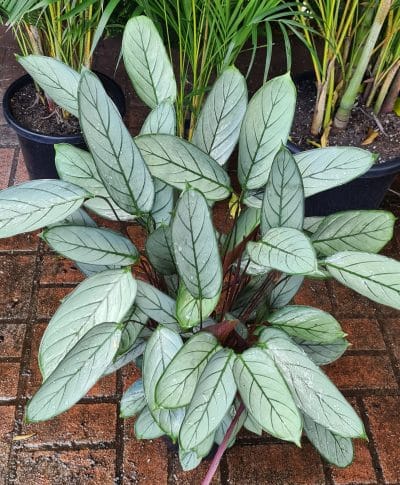
Ctenanthe Grey Star
Ctenanthe Grey Star is a popular houseplant with striking foliage that features silvery-green leaves with dark green stripes and purple undersides. Here are some care tips for keeping your Ctenanthe Grey Star healthy and thriving:
Lighting:This plant prefers bright, indirect light, but it can also tolerate low to medium light levels. Avoid exposing it to direct sunlight, as this can scorch the leaves.
Water:
Keep the soil evenly moist, but not wet. Water when the top inch of soil feels dry to the touch, but you shouldn’t let the soil dry out completely.
Use room temperature water to avoid shocking the roots. Water until water comes out of the pot. Do not let the plant sit in water.
As a general guideline, you can water your Ctenanthe Grey Star every 5-7 days during the growing season (spring and summer) and reduce the frequency to once every two weeks during the dormant season (fall and winter). However, you should always check the soil moisture level before watering and adjust the frequency accordingly.
Overwatering can cause root rot, so make sure the pot has drainage holes and the soil is well-draining.
Humidity: This plant loves humidity, so mist the leaves regularly or place a tray of water near the plant to increase the moisture in the air. Alternatively, you can use a humidifier to maintain a consistent level of humidity.
Temperature: Ctenanthe Grey Star prefers temperatures between 65-80°F (18-27°C). Avoid exposing it to temperatures below 60°F (15°C) or above 85°F (29°C), as this can cause stress and damage to the plant.
Fertilizer: Feed your Ctenanthe Grey Star with a balanced, water-soluble fertilizer once a month during the growing season (spring and summer). Avoid fertilizing during the winter months when the plant is dormant.
Pruning: Trim any yellow or brown leaves as soon as you notice them to prevent disease and pests from spreading. You can also prune back leggy stems to encourage bushier growth.

Australian Fan Palm (Licuala ramsayi)
Licuala ramsayi, commonly known as the Australian fan palm, is a tropical plant native to Queensland, Australia. Here are some care tips for Licuala ramsayi:
Light: Licuala ramsayi prefers bright but filtered light, so it’s best to place it near a window with filtered light or under a tree canopy.
Water: Keep the soil consistently moist but not waterlogged. Overwatering can cause root rot, so it’s important to allow the soil to dry out slightly before watering again.
Humidity: Licuala ramsayi thrives in high humidity, so it’s a good idea to mist the plant regularly or place a humidifier nearby.
Soil: Use a well-draining, rich soil mix with plenty of organic matter. Avoid soils that are heavy in clay or sand.
Temperature: Licuala ramsayi prefers warm temperatures between 65-85°F (18-29°C). Avoid exposing the plant to temperatures below 55°F (12°C).
Fertilizer: Fertilize Licuala ramsayi every 2-3 months during the growing season with a balanced, slow-release fertilizer.
Pruning: Remove any yellow or damaged leaves as they appear to maintain the plant’s health and appearance.
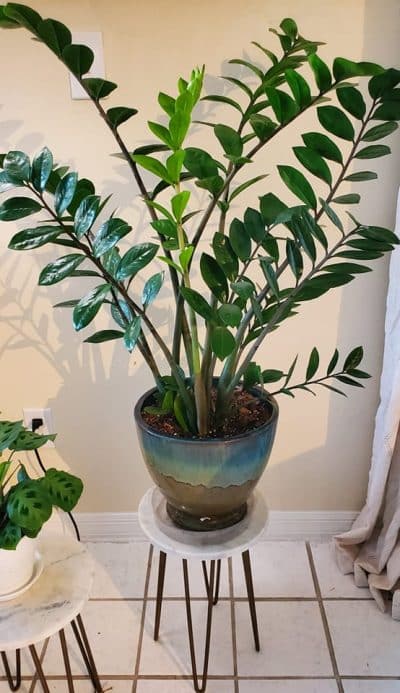
Zamioculcas zamiifolia (ZZ plant)
Zamioculcas zamiifolia, also known as the ZZ plant, is a popular houseplant due to its easy care (thrive on neglect) and attractive foliage. Here are some care tips for your ZZ plant:
Light: ZZ plants prefer bright, indirect light but can tolerate lower light levels. Avoid direct sunlight as it can burn the leaves.
Water: Every 2-4 weeks. ZZ plants are drought-tolerant and can go for extended periods without water. Water your ZZ plant when the top 1-2 inches of soil is dry to the touch, and be sure to avoid overwatering, as this can lead to root rot.
Humidity: ZZ plants can tolerate low humidity, but they will appreciate occasional misting or placement near a humidifier.
Soil: Use a well-draining potting mix to avoid waterlogged soil.
Temperature: ZZ plants prefer warm temperatures between 65-75°F (18-24°C) and can tolerate temperatures as low as 45°F (7°C).
Fertilizer: ZZ plants do not require frequent fertilization. Apply a balanced, water-soluble fertilizer once a month during the growing season (spring and summer).
Repotting: ZZ plants do not require frequent repotting and can grow well in small containers. Repot every 2-3 years or when the plant has outgrown its current container.
By following these care tips, you can help ensure that your ZZ plant remains healthy and attractive for years to come.

Devil’s Ivy (Golden Pothos)
Golden Pothos, also known as Devil’s Ivy, is a popular houseplant that is easy to care for. Here are some care tips for your Golden Pothos:
Light: Golden Pothos prefers bright, indirect light but also do well in low light conditions. Too much direct sunlight can scorch the leaves and too little light can cause the plant to become leggy.
Water: Water your Golden Pothos when the top inch of soil feels dry to the touch. Be careful not to overwater as this can lead to root rot. Let your pothos plant’s soil dry out completely between waterings. Black spots on the leaves (or the sudden collapse of the plant) indicate that the soil has been kept too wet. The plant will indicate when it needs water. When it starts to droop, it needs water to revive it.
Soil:Use a well-draining potting mix for your Golden Pothos. You can also add perlite or sand to improve drainage.
Temperature and Humidity: Golden Pothos prefers temperatures between 65-85°F (18-29°C) and moderate to high humidity. You can increase humidity by placing a tray of water near the plant or using a humidifier.
Fertilizer: Feed your Golden Pothos once a month with a balanced fertilizer during the growing season (spring and summer). Do not fertilize during the winter months when the plant is dormant.
Pruning: Prune your Golden Pothos regularly to encourage bushy growth and remove any dead or yellowing leaves. You can also propagate the plant by rooting stem cuttings in water or soil.
Overall, Golden Pothos is a relatively low-maintenance houseplant that can thrive in a variety of conditions. With the right care, your Devil’s Ivy can be a beautiful addition to your home or office.
What our Customers Say
A fantastic choice of healthy plants. Excellent service and delivery, we even received information on how to care for our specific plants. Jade went above and beyond to deliver it to us after hours. Highly recommended.
Peta Lugg
Bought here a beautiful plant for my daughter’s Christmas. It was my first visit, and I couldn’t have been happier with the range and the reasonable prices for the top quality plants I could choose from.
The service was also excellent with lots of advice on how to care for the plant.
Will visit again!
Frances Dehaix
What a great buying experience it was me at Ruby plants.
I am not very knowledgeable about plants and had lots of questions.
The owner helped me with everything I needed to know and gave me great advice about picking the plants.
They have beautiful plants and amazing prices that just get better with the more you buy.
She also sent me all the plant care info after I had left for the many species I purchased and even followed up with extra advice.
Highly recommend!
Ben Murray
One of the best places to buy your indoor and outdoor plants for your house. The staff was friendly and helped them to selected the best for our home. Thank you and we will be coming here definitely for our next plant purchase .
Suhashi Mallimarachchi
Large healthy gorgeous looking plants at the best prices in Brisbane. Very friendly and knowledgeable owners. Highly recommended. I bought 5 big red lillypillys and they are the best trees I’ve seen. These are usually double or triple the price and that’s if you can even find them to buy. Will definitely be returning to this hidden gem.
Francine Arnold
Get a Free Quote or Ask a Question
Complete the form below or call us on 0411 852 098 directly
Disclaimer: All information is kept secure and will not be shared or sold to any third party.
